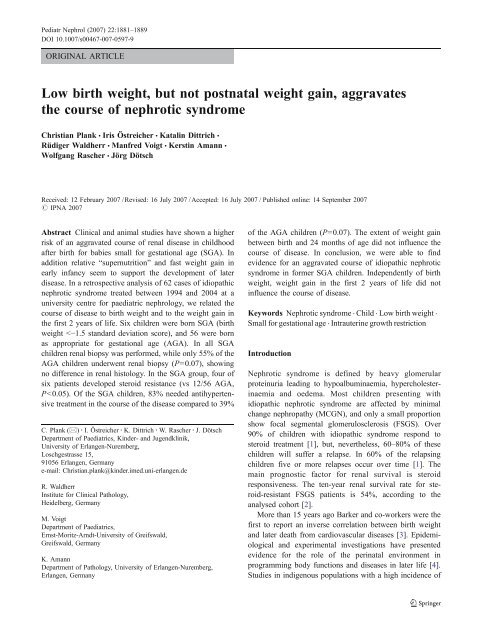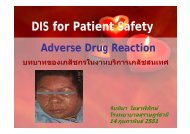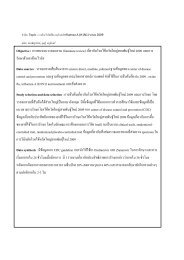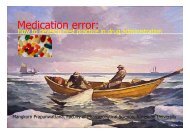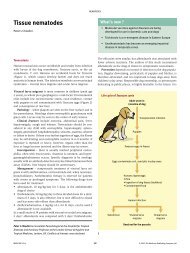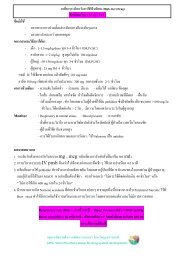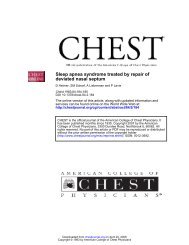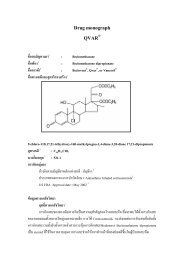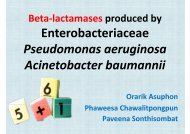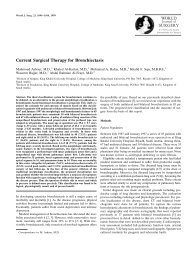Low birth weight, but not postnatal weight gain ... - Thai Wonders
Low birth weight, but not postnatal weight gain ... - Thai Wonders
Low birth weight, but not postnatal weight gain ... - Thai Wonders
You also want an ePaper? Increase the reach of your titles
YUMPU automatically turns print PDFs into web optimized ePapers that Google loves.
Pediatr Nephrol (2007) 22:1881–1889<br />
DOI 10.1007/s00467-007-0597-9<br />
ORIGINAL ARTICLE<br />
<strong>Low</strong> <strong>birth</strong> <strong>weight</strong>, <strong>but</strong> <strong>not</strong> <strong>postnatal</strong> <strong>weight</strong> <strong>gain</strong>, aggravates<br />
the course of nephrotic syndrome<br />
Christian Plank & Iris Östreicher & Katalin Dittrich &<br />
Rüdiger Waldherr & Manfred Voigt & Kerstin Amann &<br />
Wolfgang Rascher & Jörg Dötsch<br />
Received: 12 February 2007 /Revised: 16 July 2007 /Accepted: 16 July 2007 / Published online: 14 September 2007<br />
# IPNA 2007<br />
Abstract Clinical and animal studies have shown a higher<br />
risk of an aggravated course of renal disease in childhood<br />
after <strong>birth</strong> for babies small for gestational age (SGA). In<br />
addition relative “supernutrition” and fast <strong>weight</strong> <strong>gain</strong> in<br />
early infancy seem to support the development of later<br />
disease. In a retrospective analysis of 62 cases of idiopathic<br />
nephrotic syndrome treated between 1994 and 2004 at a<br />
university centre for paediatric nephrology, we related the<br />
course of disease to <strong>birth</strong> <strong>weight</strong> and to the <strong>weight</strong> <strong>gain</strong> in<br />
the first 2 years of life. Six children were born SGA (<strong>birth</strong><br />
<strong>weight</strong>
1882 Pediatr Nephrol (2007) 22:1881–1889<br />
neonatal hypotrophy show, in addition, a higher risk for<br />
renal insufficiency in adult life, which is difficult to<br />
separate from the risk of metabolic diseases in these<br />
populations [5–7]. A<strong>not</strong>her aspect in perinatal programming<br />
of later diseases is <strong>postnatal</strong> growth and <strong>weight</strong> <strong>gain</strong>.<br />
It is postulated that catch-up growth until the age of 2 years<br />
restores the infant’s size back to the genetic growth<br />
trajectory [8]. Up to 90% of children born small for<br />
gestational age (SGA) show catch-up growth [9]. Barker<br />
et al. studied the influence of <strong>postnatal</strong> growth on<br />
cardiovascular events in later life and showed that adults<br />
who had suffered coronary events were smaller at <strong>birth</strong>, thin<br />
at 2 years and had showed rapid <strong>weight</strong> <strong>gain</strong> thereafter.<br />
Other groups have shown negative consequences of catchup<br />
growth on blood pressure, death from cardiovascular<br />
diseases and occurrence of type 2 diabetes [10]. In a cohort<br />
study Ong et al. showed an association between children’s<br />
catch-up growth in the first 2 years of life and their fatness<br />
at the age of 5 years. Of the children studied, 30.7% had a<br />
<strong>weight</strong> <strong>gain</strong> of 0.67 standard deviation score (SDS).<br />
Interestingly, these children had lower <strong>birth</strong> <strong>weight</strong>s,<br />
lengths and ponderal indices [11]. Data from the US<br />
Collaborative Perinatal Project (1959–1974) looked at<br />
blood pressure elevation at the age of 7 years. This study<br />
did <strong>not</strong> show an elevated risk for SGA children <strong>but</strong><br />
demonstrated a higher risk in children who crossed <strong>weight</strong><br />
percentiles during early childhood [12]. A smaller Korean<br />
study showed a connection between <strong>weight</strong> <strong>gain</strong> in the first<br />
3 years of life and increased systolic blood pressure at the<br />
age of 3 years [13]. In conclusion, infant <strong>weight</strong> <strong>gain</strong> could<br />
be a risk factor for the course of later diseases independently<br />
from SGA or intrauterine growth restriction (IUGR).<br />
To date, three studies on children have looked for SGA<br />
as a risk factor for an aggravated course of idiopathic<br />
nephrotic syndrome. Two of these studies were performed<br />
in an Asian population [14, 15] and one was done in<br />
Slovenian children [16]. They all showed an unfavourable<br />
course of nephrotic syndrome in SGA children. However,<br />
there are no studies that examine the influence of early<br />
<strong>postnatal</strong> growth on the course of kidney diseases. Two of<br />
the studies were limited to children with clinical diagnoses<br />
of idiopathic nephrotic syndrome or minimal change<br />
disease [14, 16]. Therefore, we investigated our complete<br />
cohort of children with idiopathic nephrotic syndrome due<br />
to MCGN or FSGS to test the hypothesis that low <strong>birth</strong><br />
<strong>weight</strong> and early <strong>weight</strong> <strong>gain</strong> are risk factors for an<br />
aggravated course of idiopathic nephrotic syndrome.<br />
Methods<br />
We retrospectively investigated every treated case of<br />
idiopathic nephrotic syndrome between 1994 and 2004 in<br />
a university centre for paediatric nephrology. In a first step,<br />
all patients treated because of nephrotic syndrome, MCGN<br />
or FSGS were identified by the diagnostic codes 580.-,<br />
581.-, 582.-, 583.- (ICD 9) or N00., N01., N04., N05.,<br />
N06., and N08.8 (ICD 10) in a patients’ database. Then, we<br />
selected all patients with the clinical diagnosis of idiopathic<br />
nephrotic syndrome or the histological diagnosis MCGN or<br />
FSGS. Patients were 1–18 years old when nephrotic<br />
syndrome was diagnosed. Patients with chromosomal<br />
aberrations, congenital syndromes and congenital infections<br />
were excluded. The selected families were contacted.<br />
Informed consent of the parents and as far as possible<br />
assent of the patients were obtained. Copies were drawn<br />
from the patients’ prevention record with auxiology data at<br />
<strong>birth</strong>, days 3–10, weeks 4–6, months 3–4, months 6–7,<br />
months 10–12 and months 21–24, according to the German<br />
national child prevention program. Parents answered a<br />
questionnaire about parental auxiology, pregnancy and risk<br />
factors during pregnancy. Patient records were analysed for<br />
data on diagnosis, clinical course and therapy.<br />
The study protocol was approved by the ethics committee<br />
of the medical faculty of the University of Erlangen-<br />
Nuremberg. The study was conducted according to the<br />
Declaration of Helsinki and German national laws.<br />
The definition of small for gestational age is very<br />
arbitrary, ranging from the 2.5th percentile to the 25th<br />
percentile [17]. Therefore, to distinguish between patients<br />
that were small for gestational age and those that were<br />
appropriate for gestational age, we used a <strong>birth</strong>-<strong>weight</strong><br />
standard deviation score (SDS) ≤−1.5 (equivalent to the 7th<br />
percentile). SDS was calculated according to <strong>birth</strong> <strong>weight</strong>,<br />
gestational age and gender, using the percentiles of M.<br />
Voigt for German newborns between 1995–1997 [18]. The<br />
same references were used for calculation of the SDSs for<br />
head circumference and <strong>birth</strong> length. The ponderal index<br />
was calculated according to the formula: body <strong>weight</strong> (g)/<br />
[body length (cm)] 3 .<br />
In fact, <strong>not</strong> only patients with a <strong>birth</strong> <strong>weight</strong> below the<br />
10th percentile or the
Pediatr Nephrol (2007) 22:1881–1889 1883<br />
Independent of <strong>birth</strong> <strong>weight</strong>, <strong>postnatal</strong> alimentation and<br />
<strong>weight</strong> <strong>gain</strong> in early childhood might influence the later<br />
course of kidney diseases. As a proxy for <strong>postnatal</strong> <strong>weight</strong><br />
<strong>gain</strong> we analysed the difference between body <strong>weight</strong> SDSs<br />
at <strong>birth</strong> and at 24 months of age [11]. Percentile-crossing<br />
<strong>weight</strong> <strong>gain</strong> or loss can be shown as <strong>gain</strong> or loss of SDSs<br />
[12]. For example, a patient with a <strong>birth</strong> <strong>weight</strong> at the 2.3th<br />
percentile and <strong>weight</strong> at the 15.9th percentile at the age of<br />
2 years would present with a <strong>gain</strong> of SDS of 1.0, indicating<br />
catch-up growth. In contrast, a SDS difference 1.0).<br />
SDSs were calculated on the basis of dry <strong>weight</strong>.<br />
As characteristics of the clinical course we used age at<br />
manifestation, necessity of renal biopsy, histological diagnosis,<br />
rate of primary and secondary steroid resistance, rate<br />
of primary and secondary steroid dependence, use of<br />
cyclophosphamide or cyclosporin A, rate of arterial hypertension<br />
in the course of disease, number of antihypertensive<br />
or antiproteinuric drugs, and number of relapses per year of<br />
follow-up. At last follow-up, number of patients with endstage<br />
renal failure, creatinine clearance according to<br />
Schwartz [22], number of antihypertensive or antiproteinuric<br />
drugs and immunosuppressive drugs were determined.<br />
Ambulatory blood pressure measurements are given as<br />
SDSs. SDSs were calculated on the basis of the data by de Man<br />
[23]. Formulae were provided by Elke Wühl, Department of<br />
Pediatrics, University of Heidelberg, Germany.<br />
For the scoring of antihypertensive therapy, the following<br />
drugs were considered: captopril, enalapril, atenolol, propranolol,<br />
nifedipin, amlodipin, prazosin and dihydralazin.<br />
The use of each class of antihypertensive or antiproteinuric<br />
drug during the course of the disease was given one score<br />
point, with a maximum score of 4.<br />
Further definitions<br />
Nephrotic syndrome was defined as proteinuria [urinary<br />
protein excretion >40 mg/m 2 per hour (=1 g/m 2 per<br />
24 hours)], oedema, and hypoalbuminaemia (serum albumin<br />
level 40 mg/m 2 per<br />
hour (1 g/m 2 per day) or as protein excretion >100 mg/dl in<br />
three successive analyses of morning spot urine. Therapy<br />
for relapses followed the APN standard, with 60 mg/m 2<br />
BSA PRD divided into three single doses and the largest<br />
dose in the morning (maximum dose 80 mg/day) until<br />
morning spot urine showed protein excretion
1884 Pediatr Nephrol (2007) 22:1881–1889<br />
nephritis, and a<strong>not</strong>her patient had nephronophtisis. All<br />
these patients were excluded from further analysis. Six<br />
children were identified as SGA, 56 as AGA (Table 1). In<br />
SGA und AGA children median gestational age was<br />
similar. Both groups differed significantly in <strong>birth</strong> <strong>weight</strong>,<br />
<strong>birth</strong> length and head circumference. Birth <strong>weight</strong> SDS,<br />
<strong>birth</strong> length SDS and head circumference differed significantly<br />
after correction for gestational age and gender.<br />
Auxiology after <strong>birth</strong> in SGA children<br />
In the SGA group <strong>birth</strong> <strong>weight</strong> SDS was between −3.91 and<br />
−1.51. To describe catch up growth in the SGA group we<br />
analysed <strong>weight</strong> development and growth during the first<br />
2 years of life. In one patient auxiology data from <strong>birth</strong><br />
until the age of 2 years was completely missing.<br />
There was no body <strong>weight</strong> catch-up in three patients; the<br />
other two patients increased their body <strong>weight</strong> at least by<br />
0.5 SDS. No patient reached a body <strong>weight</strong> SDS over 1.2 at<br />
24 months of age.<br />
One patient did <strong>not</strong> attain a normal body length<br />
according to SDS till the age of 24 months. Two patients<br />
showed an increase in length SDS>1.5. A<strong>not</strong>her two<br />
patients showed a normal height SDS (>−2.0) at 24 months,<br />
<strong>but</strong> catch-up details regarding height SDS between <strong>birth</strong><br />
and 24 months were missing. Because of the small number<br />
of SGA patients, further analysis on the influence of catchup<br />
growth after SGA was omitted.<br />
Table 1 Patients’ characteristics at <strong>birth</strong>. Data are given as median<br />
and range<br />
Characteristic SGA (n=6) AGA (n=56)<br />
Gestational age (weeks) 39.5 (37–41) 40 (29–42)<br />
Gender (male/female) 3/3 32/24<br />
Birth <strong>weight</strong> (g) 2,735 (1,280– 3,400 (1,320–<br />
2,950)<br />
4,380) a<br />
Birth <strong>weight</strong> (SDS) −1.84 (−3.91– −0.28 (−1.45–<br />
−1.51)<br />
+1.72) b<br />
Birth length (cm) 49.5 (36.0–50.0) 51.5 (39.0–58.0) b<br />
Birth length (SDS) −1.21 (−5.67– −0.08 (−1.88–<br />
−0.79)<br />
2.37) a<br />
Ponderal index 2.38 (2.09–2.74) 2.41 (2.1–2.93)<br />
Head circumference at <strong>birth</strong><br />
(cm)<br />
33.2 (32.8–35.0) 35.0 (29.0–38.0) b<br />
Head circumference at <strong>birth</strong> −1.29 (−1.72– −0.04 (−1.93–<br />
(SDS)<br />
−0.42)<br />
1.86) b<br />
Differences between both groups are tested with unpaired Mann–<br />
Whitney t-test<br />
a P
Pediatr Nephrol (2007) 22:1881–1889 1885<br />
Table 3 Clinical course of idiopathic nephrotic syndrome in SGA and<br />
AGA children. Data are given as median and range<br />
Parameter SGA (n=6) AGA (n=56)<br />
Age at manifestation (years) 6.4 (1.9–15.3) 3.7 (1.2–15.5)<br />
Follow-up period (years) 6.2 (2.2–17.2) 5.4 (0.2–15.7)<br />
Cyclophosphamide therapy<br />
required<br />
5/6 (83.3%) 30/56 (53.6%)<br />
Cyclosporin A therapy required 5/6 (83.3%) 23/56 (41.1%)<br />
Steroid dependence 2/6 (33.3%) 20/56 (35.5%)<br />
Steroid resistance 4/6 (66.6%) 12/56 (21.4%) a<br />
Relapses per patient/year 0.69 (0–2.41) 0.65 (0–3.0)<br />
Renal biopsy performed 6/6 (100%) 31/56 (55%)<br />
Minimal change glomerulopathy<br />
(MCGN)<br />
5/6 (83.3%) 23/31 (74.1%)<br />
Focal segmental<br />
glomerulosclerosis (FSGS)<br />
1/6 (16.6%) 8/31 (25.8%)<br />
Differences between both groups were tested with unpaired Mann–<br />
Whitney t-test and Fisher’s exact test<br />
a P
1886 Pediatr Nephrol (2007) 22:1881–1889<br />
nosis, or use of immunosuppressive substances; neither was<br />
need for antihypertensive treatment, blood pressure at last<br />
follow-up, or use of antihypertensive drugs different<br />
between the four groups. Median number of relapses per<br />
patient year was <strong>not</strong> different, <strong>but</strong> interestingly, patients in<br />
the <strong>birth</strong> SDS group 0–1.0 had a bigger chance of facing a<br />
relapse-free remission (P
Pediatr Nephrol (2007) 22:1881–1889 1887<br />
Table 6 Clinical course of idiopathic nephrotic syndrome in relation to <strong>weight</strong> <strong>gain</strong> in the first 24 months of life. Data are given as median and<br />
range<br />
Parameter Weight <strong>gain</strong><br />
Weight <strong>gain</strong><br />
Weight <strong>gain</strong><br />
Weight <strong>gain</strong><br />
month 0–24<br />
month 0–24<br />
month 0–24<br />
month 0–24<br />
1.0 SDS (n=13)<br />
Age at manifestation (years) 4.5 (1.2–8.0) 3.9 (1.6–7.2) 3.9 (2.1–15.3) 2.9 (1.5–14.8)<br />
Follow-up period (years) 5.4 (4.2–17.25) 4.96 (1.7–11.7) 4.8 (0.9–14.2) 5.3 (0.2–15.2)<br />
Cyclophosphamide therapy required 5/7 (71.4%) 6/14 (42.8%) 8/19 (42.1%) 9/13 (69.2%)<br />
Cyclosporin A therapy required 4/7 (57.5%) 6/14 (42.8%) 4/19 (21.0%) 6/13 (46.1%)<br />
Steroid resistance 4/7 (57.1%) 3/14 (21.4%) 3/19 (15.8%) 4/13 (30.7%)<br />
Steroid dependence 3/7 (42.9%) 5/14 (35.7%) 4/19 (21.0%) 3/13 (23.0%)<br />
Relapses per patient per year 1.0 (0–2.4) 0.56 (0–2.2) 0.57 (0–3.0) 0.7 (0–1.8)<br />
Renal biopsy performed 4/7 (57.1%) 9/14 (64.2%) 7/19 (36.0%) 9/13 (69.2%)<br />
Minimal change glomerulopathy<br />
(MCGN)<br />
2/4 8/9 5/7 6/9<br />
Focal segmental glomerulosclerosis<br />
(FSGS)<br />
2/4 1/9 2/7 3/9<br />
Differences between both groups were tested with one-way analysis of variance (ANOVA) and chi-square test<br />
clinically suspected or proven by biopsy, the authors<br />
identified five children who had been SGA. In the SGA<br />
group, a higher number of relapses, a higher rate of steroid<br />
dependency, use of cytotoxic drugs, and a higher rate of<br />
renal biopsy could be observed. Sheu and Chen [14]<br />
studied 50 Taiwanese children (1–13 years) with nephrotic<br />
syndrome, half of them with biopsy proven MCGN. Eight<br />
children were identified as having been SGA (<strong>birth</strong> <strong>weight</strong><br />
below 10th percentile). A higher rate of renal biopsy, higher<br />
serum lipids at first manifestation, more steroid dependence,<br />
higher number of relapses and a high proportion of<br />
hypertension in SGA children were shown. In a third paper<br />
Na and co-workers [15] analysed the records of 56 Korean<br />
children with nephrotic syndrome. In their study steroid<br />
resistance was seen significantly more often in the SGA<br />
group. Zidar et al. and Na et al. investigated only MCGN<br />
patients, Sheu and Chen identified at least one patient with<br />
FSGS in their SGA cohort by renal biopsy. We were able to<br />
confirm a high rate of renal biopsies in SGA children. In<br />
contrast to those studies, we tried to investigate all our<br />
patients with the clinical diagnosis of idiopathic nephrotic<br />
syndrome and we included patients with FSGS as well.<br />
Twenty-eight patients had a biopsy proven MCGN, and<br />
nine patients out of 62 (14.5%) had FSGS. The FSGS rate<br />
was higher than that reported in the International Study of<br />
Kidney Disease in Children (ISKDC), with an FSGS rate of<br />
7.9% [28]. This may explain the high rate of primary and<br />
secondary steroid resistance (25%) in our cohort. Nevertheless,<br />
the rate of steroid resistance was higher in the SGA<br />
cohort. This is in line with our finding that the age at<br />
manifestation was higher in the SGA group <strong>but</strong> did <strong>not</strong><br />
reach statistical significance. A median age of 2.5 years is<br />
typical for steroid-responsive patients; patients with primary<br />
steroid resistance present at a median age of 6 years [29].<br />
Newer studies observe increasing rates of steroid resistance<br />
in childhood nephrotic syndrome [30]. Steroid responsiveness<br />
is an important prognostic parameter of idiopathic<br />
nephrotic syndrome [31]. Nevertheless, we could <strong>not</strong> find<br />
patients with renal failure in our study, which can be<br />
expected in FSGS patients. A sampling error because the<br />
data had been collected at a paediatric nephrology referral<br />
centre, and the short observation period, may be explanations<br />
for the difference in steroid resistance and renal survival.<br />
In contrast to the published studies, we tried to analyse<br />
the influence of <strong>postnatal</strong> <strong>weight</strong> <strong>gain</strong> on the later course of<br />
disease. In our small SGA cohort we could <strong>not</strong> find a clear<br />
pattern of catch-up growth, and, therefore, we could <strong>not</strong><br />
address the influence of catch-up growth of SGA children<br />
on the course of nephrotic syndrome in later life in this<br />
study. To find a connection between <strong>postnatal</strong> <strong>weight</strong> <strong>gain</strong><br />
and the course of disease independent of <strong>birth</strong> <strong>weight</strong>, we<br />
tried to analyse the clinical course of nephrotic syndrome in<br />
relation to the <strong>weight</strong> <strong>gain</strong> shown as SDS difference<br />
between <strong>birth</strong> and 24 months of age. Between the four<br />
groups with an SDS difference 1.0, there was no difference in the main aspects of clinical<br />
course of nephrotic syndrome. Even though the number of<br />
patients was too low for multiple regression analysis, the<br />
comparison of the different groups may give an approximation<br />
for the missing influence of <strong>postnatal</strong> percentile-crossing<br />
<strong>weight</strong> <strong>gain</strong>. This question should be further pursued in a<br />
bigger and, as far as possible, prospective study.<br />
A<strong>not</strong>her interesting feature of our study and the cited<br />
papers on nephrotic syndrome in former SGA children is the<br />
higher rate of hypertension in the SGA cohort. The high rate<br />
of hypertension and the need for hypertensive treatment may<br />
be confounded by the use of cyclosporine A and recurrent<br />
prednisone treatment. Nevertheless, for long-term treatment
1888 Pediatr Nephrol (2007) 22:1881–1889<br />
with cyclosporin A, the rate of hypertension is 10% [32] or<br />
even below [33]. Development of elevated blood pressure is<br />
one of the key features of perinatal programming by IUGR<br />
[4], even though a meta-analysis of epidemiological studies<br />
saw a weaker association between <strong>birth</strong> <strong>weight</strong> and later<br />
hypertension [34] than initially suspected. Animal studies<br />
analysed potential mechanisms of perinatal programming.<br />
The main renal phe<strong>not</strong>ype of IUGR is nephron reduction,<br />
which could be demonstrated in different animal models of<br />
IUGR and SGA [7, 35]. Autopsy studies confirmed the<br />
inverse correlation between <strong>birth</strong> <strong>weight</strong> and nephron<br />
number in humans [36]. Nephron reduction itself is seen as<br />
a possible risk factor for the later development of hypertension<br />
[37]. Studies in IUGR animals revealed further<br />
influences on the development of hypertension, such as salt<br />
intake [38, 39] or <strong>postnatal</strong> nutrition [40]. Nephron deficit,<br />
perhaps in combination with other <strong>postnatal</strong> factors, is a risk<br />
for the progression of secondary renal diseases. Zimanyi et<br />
al. demonstrated an increased susceptibility to secondary<br />
renal injury due to advanced gylcation products in a low<br />
protein model of IUGR [41]. Our group showed increased<br />
renal damage in anti-Thy1 nephritis as a model of<br />
mesangioproliferative glomerulonephritis in a similar IUGR<br />
model [42]. Even though studies on possible mechanisms in<br />
nephrotic children are still missing, these animal studies<br />
support the hypothesis that IUGR is a risk factor for the<br />
progression of secondary renal injury such as idiopathic<br />
nephrotic syndrome. Therefore, rather than nephron number,<br />
altered glomerular inflammatory reaction might be involved<br />
in the pathogenesis of nephrotic syndrome.<br />
Analyses of genetic forms of nephrotic syndrome have<br />
provided huge knowledge on the structure and function of<br />
the slit diaphragma [1, 43]. The pathogenesis of idiopathic<br />
nephrotic syndrome is still unclear, although studies of FSGS<br />
have suggested the existence of a putative permeability<br />
factor [44–46] probably derived from T cells [47]. The<br />
relationship between MCGN and primary allergic reaction is<br />
still under discussion [1]. More interesting are differences in<br />
the phe<strong>not</strong>ype, cytokine profiles and function of lymphocytes<br />
of nephrotic patients during relapse in remission [48–51]. In<br />
immunological studies of SGA cohorts, a reduced number of<br />
T cells, a higher number of CD8-positive cells and delayed<br />
hypersensitivity reaction were detectable [52, 53]. Knowledge<br />
of the immunological consequences of IUGR is limited<br />
at the moment. Therefore, since idiopathic nephrotic syndrome<br />
is, at least partly, mediated by T cells, one might<br />
speculate that an alteration in T cell response might be<br />
involved in the pathogenesis of more severe nephrotic<br />
syndrome in children with low <strong>birth</strong> <strong>weight</strong>.<br />
In conclusion, we were able to find further evidence for the<br />
influence of low <strong>birth</strong> <strong>weight</strong>, <strong>but</strong> <strong>not</strong> for <strong>postnatal</strong> <strong>weight</strong><br />
<strong>gain</strong>, on the clinical course of secondary renal injury in a<br />
cohort of children with idiopathic nephrotic syndrome. The<br />
mechanisms involved are <strong>not</strong> well understood. Perinatal<br />
programming as an additional pathogenic principal in renal<br />
disease needs further investigation. Investigation of the role of<br />
early catch-up growth should be included in further studies.<br />
Acknowledgements This study was supported by a grant from the<br />
Deutsche Forschungsgemeinschaft, Bonn, Germany; SFB 423,<br />
Collaborative Research Centre of the German Research Foundation<br />
Kidney Injury: Pathogenesis and Regenerative Mechanisms, project<br />
B13, to Wolfgang Rascher and Jörg Dötsch, and project Z2 to Kerstin<br />
Amann. We thank Elke Wühl for the data for SDS calculation of<br />
spontaneous blood pressure measurement in children. We gratefully<br />
appreciate the support of Melek Düz in conducting this study.<br />
References<br />
1. Eddy AA, Symons JM (2003) Nephrotic syndrome in childhood.<br />
Lancet 362:629–639<br />
2. Abrantes MM, Cardoso LS, Lima EM, Penido Silva JM, Diniz JS,<br />
Bambirra EA, Oliveira EA (2006) Predictive factors of chronic<br />
kidney disease in primary focal segmental glomerulosclerosis.<br />
Pediatr Nephrol 21:1003–1012<br />
3. Barker DJ, Winter PD, Osmond C, Margetts B, Simmonds SJ<br />
(1989) Weight in infancy and death from ischaemic heart disease.<br />
Lancet 2:577–580<br />
4. McMillen IC, Robinson JS (2005) Developmental origins of the<br />
metabolic syndrome: prediction, plasticity, and programming.<br />
Physiol Rev 85:571–633<br />
5. Lackland DT, Bendall HE, Osmond C, Egan BM, Barker DJ<br />
(2000) <strong>Low</strong> <strong>birth</strong> <strong>weight</strong>s contri<strong>but</strong>e to high rates of early-onset<br />
chronic renal failure in the southeastern United States. Arch Intern<br />
Med 160:1472–1476<br />
6. Lackland DT, Egan BM, Fan ZJ, Syddall HE (2001) <strong>Low</strong> <strong>birth</strong><br />
<strong>weight</strong> contri<strong>but</strong>es to the excess prevalence of end-stage renal disease<br />
in African Americans. J Clin Hypertens (Greenwich) 3:29–31<br />
7. Hoy WE, Hughson MD, Bertram JF, Douglas-Denton R, Amann K<br />
(2005) Nephron number, hypertension, renal disease, and renal<br />
failure. J Am Soc Nephrol 16:2557–2564<br />
8. Tanner JM (1986) Childhood epidemiology. Physical development.<br />
Br Med Bull 42:131–138<br />
9. Karlberg J, Albertsson-Wikland K (1995) Growth in full-term<br />
small-for-gestational-age infants: from <strong>birth</strong> to final height.<br />
Pediatr Res 38:733–739<br />
10. Hales CN, Ozanne SE (2003) For debate: Fetal and early <strong>postnatal</strong><br />
growth restriction lead to diabetes, the metabolic syndrome and<br />
renal failure. Diabetologia 46:1013–1019<br />
11. Ong KK, Ahmed ML, Emmett PM, Preece MA, Dunger DB<br />
(2000) Association between <strong>postnatal</strong> catch-up growth and obesity<br />
in childhood: prospective cohort study. BMJ 320:967–971<br />
12. Hemachandra AH, Howards PP, Furth SL, Klebanoff MA (2007)<br />
Birth <strong>weight</strong>, <strong>postnatal</strong> growth, and risk for high blood pressure at<br />
7 years of age: results from the Collaborative Perinatal Project.<br />
Pediatrics 119:e1264–e1270<br />
13. Min JW, Kong KA, Park BH, Hong JH, Park EA, Cho SJ, Ha EH,<br />
Park H (2007) Effect of <strong>postnatal</strong> catch-up growth on blood<br />
pressure in children at 3 years of age. J Hum Hypertens<br />
DOI 10.1038/sj.jhh.1002215<br />
14. Sheu JN, Chen JH (2001) Minimal change nephrotic syndrome in<br />
children with intrauterine growth retardation. Am J Kidney Dis<br />
37:909–914<br />
15. Na YW, Yang HJ, Choi JH, Yoo KH, Hong YS, Lee JW, Kim SK<br />
(2002) Effect of intrauterine growth retardation on the progression<br />
of nephrotic syndrome. Am J Nephrol 22:463–467
Pediatr Nephrol (2007) 22:1881–1889 1889<br />
16. Zidar N, Cavic MA, Kenda RB, Koselj M, Ferluga D (1998)<br />
Effect of intrauterine growth retardation on the clinical course<br />
and prognosis of IgA glomerulonephritis in children. Nephron<br />
79:28–32<br />
17. Gardosi J (2006) New definition of small for gestational age based<br />
on fetal growth potential. Horm Res 65 [Suppl 3]:15–18<br />
18. Voigt M, Friese K, Pawlowski P, Schneider R, Wenzlaff P,<br />
Wermke K (2001) Analysis of newborns in Germany between<br />
1995 and 1997. Part 6: differences in <strong>birth</strong> <strong>weight</strong> classification<br />
among states. Geburtshilfe Frauenheilkd 61:700–706<br />
19. Barker DJ, Osmond C, Forsen TJ, Kajantie E, Eriksson JG (2005)<br />
Trajectories of growth among children who have coronary events<br />
as adults. N Engl J Med 353:1802–1809<br />
20. Cole TJ, Freeman JV, Preece MA (1998) British 1990 growth<br />
reference centiles for <strong>weight</strong>, height, body mass index and head<br />
circumference fitted by maximum penalized likelihood. Stat Med<br />
17:407–429<br />
21. Prader A, Largo RH, Molinari L, Issler C (1989) Physical growth<br />
of Swiss children from <strong>birth</strong> to 20 years of age. First Zurich<br />
longitudinal study of growth and development. Helv Paediatr Acta<br />
Suppl 52:1–125<br />
22. Schwartz GJ, Gauthier B (1985) A simple estimate of glomerular<br />
filtration rate in adolescent boys. J Pediatr 106:522–526<br />
23. de Man SA, Andre JL, Bachmann H, Grobbee DE, Ibsen KK,<br />
Laaser U, Lippert P, Hofman A (1991) Blood pressure in childhood:<br />
pooled findings of six European studies. J Hypertens 9:109–114<br />
24. Ehrich JH, Brodehl J (1993) Long versus standard prednisone<br />
therapy for initial treatment of idiopathic nephrotic syndrome in<br />
children. Arbeitsgemeinschaft fur Padiatrische Nephrologie. Eur J<br />
Pediatr 152:357–361<br />
25. Hodson EM, Craig JC, Willis NS (2005) Evidence-based<br />
management of steroid-sensitive nephrotic syndrome. Pediatr<br />
Nephrol 20:1523–1530<br />
26. Brodehl J (1981) Alternate-day prednisone is more effective than<br />
intermittent prednisone in frequently relapsing nephrotic syndrome.<br />
Eur J Pediatr 135:229–237<br />
27. Zidar N, Avgustin Cavic M, Kenda RB, Ferluga D (1998) Unfavorable<br />
course of minimal change nephrotic syndrome in children with<br />
intrauterine growth retardation. Kidney Int 54:1320–1323<br />
28. The International Study of Kidney Disease in Children (1981) The<br />
primary nephrotic syndrome in children. Identification of patients<br />
with minimal change nephrotic syndrome from initial response to<br />
prednisone. J Pediatr 98:561–564<br />
29. Clark AG, Barratt TM (1999) Steroid responsive nephrotic syndrome.<br />
In: Barratt TM, Avner ED, Harmon WE (eds) Pediatric nephrology,<br />
4th edn. Lippincott, Williams and Wilkins, Baltimore pp 731–747<br />
30. Kim JS, Bellew CA, Silverstein DM, Aviles DH, Boineau FG,<br />
Vehaskari VM (2005) High incidence of initial and late steroid<br />
resistance in childhood nephrotic syndrome. Kidney Int<br />
68:1275–1281<br />
31. Dötsch J, Dittrich K, Plank C, Rascher W (2006) Is tacrolimus<br />
for childhood steroid-dependent nephrotic syndrome better than<br />
ciclosporin A? Nephrol Dial Transplant 21:1761–1763<br />
32. El-Husseini A, El-Basuony F, Mahmoud I, Sheashaa H, Sabry A,<br />
Hassan R, Taha N, Hassan N, Sayed-Ahmad N, Sobh M (2005)<br />
Long-term effects of cyclosporine in children with idiopathic<br />
nephrotic syndrome: a single-centre experience. Nephrol Dial<br />
Transplant 20:2433–2438<br />
33. Ponticelli C, Rizzoni G, Edefonti A, Altieri P, Rivolta E, Rinaldi S,<br />
Ghio L, Lusvarghi E, Gusmano R, Locatelli F, Pasquali S,<br />
Castellani A, Della Casa-Alberighi O (1993) A randomized trial<br />
of cyclosporine in steroid-resistant idiopathic nephrotic syndrome.<br />
Kidney Int 43:1377–1384<br />
34. Huxley R, Neil A, Collins R (2002) Unravelling the fetal origins<br />
hypothesis: is there really an inverse association between <strong>birth</strong><strong>weight</strong><br />
and subsequent blood pressure? Lancet 360:659–665<br />
35. Amann K, Plank C, Dötsch J (2004) <strong>Low</strong> nephron number—a<br />
new cardiovascular risk factor in children? Pediatr Nephrol<br />
19:1319–1323<br />
36. Hughson M, Farris AB 3rd, Douglas-Denton R, Hoy WE, Bertram JF<br />
(2003) Glomerular number and size in autopsy kidneys: the<br />
relationship to <strong>birth</strong> <strong>weight</strong>. Kidney Int 63:2113–2122<br />
37. Keller G, Zimmer G, Mall G, Ritz E, Amann K (2003) Nephron<br />
number in patients with primary hypertension. N Engl J Med<br />
348:101–108<br />
38. Manning J, Vehaskari VM (2005) Postnatal modulation of<br />
prenatally programmed hypertension by dietary Na and ACE<br />
inhibition. Am J Physiol Regul Integr Comp Physiol 288:R80–R84<br />
39. Woods LL, Weeks DA, Rasch R (2004) Programming of adult<br />
blood pressure by maternal protein restriction: role of nephrogenesis.<br />
Kidney Int 65:1339–1348<br />
40. Hoppe CC, Evans RG, Moritz KM, Cullen-McEwen LA,<br />
Fitzgerald SM, Dowling J, Bertram JF (2007) Combined<br />
prenatal and <strong>postnatal</strong> protein restriction influences adult kidney<br />
structure, function, and arterial pressure. Am J Physiol Regul<br />
Integr Comp Physiol 292:R462–R469<br />
41. Zimanyi MA, Denton KM, Forbes JM, Thallas-Bonke V,<br />
Thomas MC, Poon F, Black MJ (2006) A developmental<br />
nephron deficit in rats is associated with increased susceptibility<br />
to a secondary renal injury due to advanced glycation endproducts.<br />
Diabetologia 49:801–810<br />
42. Plank C, Östreicher I, Hartner A, Marek I, Struwe FG, Amann K,<br />
Hilgers KF, Rascher W, Dötsch J (2006) Intrauterine growth<br />
retardation aggravates the course of acute mesangioproliferative<br />
glomerulonephritis in the rat. Kidney Int 70:1974–1982<br />
43. Niaudet P (2004) Genetic forms of nephrotic syndrome. Pediatr<br />
Nephrol 19:1313–1318<br />
44. Savin VJ, Sharma R, Sharma M, McCarthy ET, Swan SK, Ellis E,<br />
Lovell H, Warady B, Gunwar S, Chonko AM, Artero M, Vincenti F<br />
(1996) Circulating factor associated with increased glomerular<br />
permeability to albumin in recurrent focal segmental glomerulosclerosis.<br />
N Engl J Med 334:878–883<br />
45. Kemper MJ, Wolf G, Muller-Wiefel DE (2001) Transmission of<br />
glomerular permeability factor from a mother to her child. N Engl<br />
J Med 344:386–387<br />
46. Carraro M, Caridi G, Bruschi M, Artero M, Bertelli R, Zennaro C,<br />
Musante L, Candiano G, Perfumo F, Ghiggeri GM (2002) Serum<br />
glomerular permeability activity in patients with podocin mutations<br />
(NPHS2) and steroid-resistant nephrotic syndrome. J Am<br />
Soc Nephrol 13:1946–1952<br />
47. Koyama A, Fujisaki M, Kobayashi M, Igarashi M, Narita M<br />
(1991) A glomerular permeability factor produced by human T<br />
cell hybridomas. Kidney Int 40:453–460<br />
48. Yan K, Nakahara K, Awa S, Nishibori Y, Nakajima N, Kataoka S,<br />
Maeda M, Watanabe T, Matsushima S, Watanabe N (1998) The<br />
increase of memory T cell subsets in children with idiopathic<br />
nephrotic syndrome. Nephron 79:274–278<br />
49. Topaloglu R, Saatci U, Arikan M, Canpinar H, Bakkaloglu A,<br />
Kansu E (1994) T-cell subsets, interleukin-2 receptor expression<br />
and production of interleukin-2 in minimal change nephrotic<br />
syndrome. Pediatr Nephrol 8:649–652<br />
50. Tomizawa S, Suzuki S, Oguri M, Kuroume T (1979) Studies of T<br />
lymphocyte function and inhibitory factors in minimal change<br />
nephrotic syndrome. Nephron 24:179–182<br />
51. Cunard R, Kelly CJ (2002) T cells and minimal change disease. J<br />
Am Soc Nephrol 13:1409–1411<br />
52. Chandra RK, Ali SK, Kutty KM, Chandra S (1977) Thymusdependent<br />
lymphocytes and delayed hypersensitivity in low <strong>birth</strong><br />
<strong>weight</strong> infants. Biol Neonate 31:15–18<br />
53. Chatrath R, Saili A, Jain M, Dutta AK (1997) Immune status of<br />
full-term small-for-gestational age neonates in India. J Trop<br />
Pediatr 43:345–348


